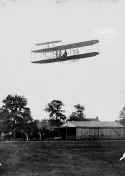|

 Up
Up 
 He Flies!
He Flies! 
(You are here.)



  Need
to Need
to
find your
bearings?
Try
these
navigation aids:
If
this is your first
visit, please stop by:
Something
to share?
Please:



|
|
Available in Française, Español, Português, Deutsch, Россию,
中文,
日本, and others.
 hile
Orville was building an airplane in Dayton, Wilbur found himself
rebuilding one in France. The airplane that Orville had packed and shipped
in 1907 was in terrible shape when Wilbur finally opened the crates. The
cloth covering was torn, oil caps smashed, the radiators mashed, seats
broken, axles bent, and ribs cracked. He sent a blistering letter to
Orville: "I opened the boxes yesterday, and have been puzzled ever
since to know how you could have wasted two whole days packing them…I am
sure that with a scoop shovel I could have put things in with two or three
minutes and made fully as good a job of it." hile
Orville was building an airplane in Dayton, Wilbur found himself
rebuilding one in France. The airplane that Orville had packed and shipped
in 1907 was in terrible shape when Wilbur finally opened the crates. The
cloth covering was torn, oil caps smashed, the radiators mashed, seats
broken, axles bent, and ribs cracked. He sent a blistering letter to
Orville: "I opened the boxes yesterday, and have been puzzled ever
since to know how you could have wasted two whole days packing them…I am
sure that with a scoop shovel I could have put things in with two or three
minutes and made fully as good a job of it."
Orville wasn't to blame — the airplane had been unpacked at French
Customs, then poorly repacked. But that did nothing to relieve the
pressure on Wilbur. With the newspapers taunting the Wrights as bluffers,
and the prospects of manufacturing airplanes in France growing more
uncertain by the day, Will was once again in need of a kind friend — and
one appeared. Leon Bollee, an automobile manufacturer and a sport
balloonist, gave Will a place to work near the racetrack at Le Mans and a
team of mechanics to help him.
But even with help, it was a daunting task to reassemble the damaged
aircraft. Will's French was rudimentary at best, so he could not explain
what needed to be done to his mechanics, and he found he had to do most of
the difficult tasks himself. He worked his hands raw sewing and stretching
wires, and badly burned himself when a radiator hose tore loose from the
engine and sprayed him with boiling water. All total, it took six weeks to
put the airframe together — twice as long as Will had planned. And then
it rained for several more weeks, creating yet another delay.
On Saturday, August 8, Wilbur Wright awoke to the day that he had
awaited for almost three years. The sky was clear, the wind nearly still,
and his steed was waiting. Later he wrote to Orville, "I thought it
would be a good thing to do a little something."
A small crowd had gathered in the racetrack's grandstands, among them
Bleriot and Archdeacon. Will was oblivious to them went as he went about
the business of making the airplane ready. He hummed a little tune as he
worked. Then, when the he was satisfied that the airplane was fit to fly,
he climbed in the left seat. The engine sputtered to life, then died —
Wilbur's back collar stud had caught on one of the wires. The stud was
freed, the engine roared to life again, and without fanfare or ceremony,
Wilbur Wright flew two complete figure-8s around the field.
The flight lasted less than two minutes. But the crowd was electrified.
Those in the grandstands who were familiar with aviation knew what wonders
they had seen. Wilbur had swept through four steeply banked turns as
graceful as a hawk — there were none of the clumsy, dangerous flat turns
that European aviators were making. Mr. Wright had control of his
aircraft.
"I would have waited 10 ten times as long to see what I have seen
today," said Bleriot. "Monsieur Wright has us all in his
hands."
Archdeacon, one of the most vociferous critics of the Wrights, had to
agree. "For too long, the Wright brothers have been accused of
bluffing. They are hallowed today in France, and I feel an intense
pleasure in counting myself among the first to make amends…"
Perhaps no one summed up the day so elegantly and succinctly as two
small boys who sneaked in under the fence for a peek at the airplane. They
grabbed their bicycles and raced back to Le Mans, shouting, "Il
vole! He flies!" |

Wilbur's hangar and temporary home in France.

Assembling the Wright Model A outside the hangar.

The completed Model A.

A close-up of the cockpit of the Model A.

Wilbur finally does a little something.

The Wright Model A in the air over France in 1908.

A late evening flight in France.
|